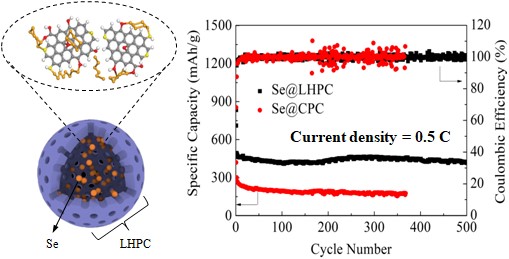P.F. Lu, F.Y. Liu, F. Zhou, J.Q. Qin, H.D. Shi, and Z.-S. Wu*
Journal of Energy Chemistry, 2021, 55, 476-483.
DOI: 10.1016/j.jechem.2020.07.022 [PDF]

Lithium-selenium (Li-Se) batteries have attracted considerable attentions for next-generation energy storage systems owing to high volumetric capacity of 3265 mAh cm−3and excellent electronic conductivity (~10−5S cm−1) of selenium.However, the shuttling effect and capacity fading prevent their wide applications. Hereinwe report a low-cost strategy for scalable fabrication of lignin derived hierarchical porous carbon (LHPC) as a new high-loading Se host for high-capacity and long-term cycling Li-Se batteries in carbonate electrolyte. The resulting LHPC exhibits three-dimensional (3D) hierarchically porous structure, high specific surface area of 1696 m2g−1, and hetero-atom doping (O, S), which can effectively confine the Se particles into the micropores, and meanwhile, offer effective chemical binding sites for selenides from hetero-atoms (O, S). As a result, our Li-Se batteries based on Se@LHPC demonstrate high capacity of 450 mAh g−1at 0.5 C after 500 cycles, with a low capacity fading rate of only 0.027%. The theoretical simulation confirmed the strong affinity of selenides on the O and S sites of LHPC effectively mitigating theSe losing.Therefore, our strategy of using lignin as the low-cost precursor of hierarchically porous carbon for high-loading Se host offers new opportunities for high-capacity and long-life Li-Se batteries.